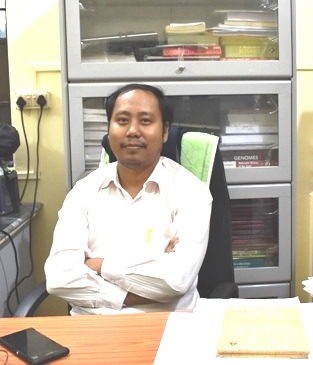Dr. Manas Das
Assistant Professor
Department of Zoology, Gauhati University
Born and brought up in Guwahati, Dr. Manas Das completed his schooling from Cotton Collegiate Govt. Higher Secondary School, Higher Secondary (Science) from Cotton College and B.Sc. (Zoology Honours) from B. Booroah College, Guwahati, Assam. He then pursued his Masters (Zoology) with specialization in Animal Physiology and Biochemistry from Gauhati University in 2005. After completion of his Masters, he joined as a JRF in the Central Silk Board project in CMERTI, Lahdoigorh, Jorhat for a period of six month. Thereafter he joined as a UGC meritorious fellow in the Department of Zoology, North Eastern Hill University, Shillong for the Ph.D. programme. He obtained his Ph.D. degree in 2014 under the supervision of Prof. Nirmalendu Saha for his thesis entitled “Effect of osmotic stress on gluconeogenesis and mitogen activated protein kinases in the air breathing catfish (Heteroponeustes fossilis)“. He also worked as a scientific officer in Forensic Science Laboratory, Government of Assam for a period of three years. He then joined as an Assistant Professor in the Department of Zoology, Gauhati University in 2014. The Department of Science Technology (Science and Engineering Research Board) granted him a project under the Early Career Research Award in 2017. He received a Start Grant from UGC – BSR in 2016 to develop a sophisticated research laboratory in the field of Animal Physiology and Biochemistry at Gauhati University. From 2016 to 2022, Dr. Das completed eight major research projects supported by DBT, DST, ICMR and ASTEC. Dr. Das is a trained molecular biologist, and his research interest is in the field of ethno-biological approaches for the development of nutraceuticals associated with the treatment of metabolic diseases like diabetics, chronic kidney disease, inflammation, and myocardial infraction. He is also interested in the research of the channel protein, “Aquaporin” thereby demonstrating it as a prognostic and diagnostic marker for systemic inflammation. Dr. Das has 30 publications to his credit in reputed peer-reviewed journals and five book chapters. He has also co-authored two books, viz. “Advanced Biochemistry” and “Computational Biology and Biostatistics” for the CBCS-UG students of Gauhati University and other state universities. He has also served as the Co-coordinator of the Bioinformatics Infrastructure Facility of Gauhati University, supported by the Department of Biotechnology, Govt. of India. He is also a member of Institutional Biosafety Committee, IPR cell and Animal Ethical Committee of Gauhati University. He is also associated with the VigyanJyoti programme of Jawahar Navodaya Vidyalaya supported by DST. He has also completed a certificate course in German language (2009) from EFL University, Shillong Campus. Dr. Das gives tremendous emphasis on popularization of science education in schools and has already participated in different programmes as a Resource Person to serve the purpose.
Awards and Recognitions:
- DST-SERB Early Career Research award in 2017
- Best Employee Award 2012 in Directorate Forensic Science, Govt. of Assam
- Best Oral Presenter in 4th International Conference on Environmental and Ecology held at Gauhati University, Guwahati from 12th-14th, February, 2018.
Team of Researchers working under Dr. Das
- Dr. Anuradha Kalita
Worked on the role of Aquaporins as potential marker of inflammation and modulation of AQP expression by Garcinia using LPS-stimulated RAW264.7 cell line and LPS-challenged Wistar rats. The study investigated the expression of different Aquaporins both at transcriptional and translational levels in the LPS-induced inflammatory response and the potential of Garcinia in decreasing the expression of the target AQPs. The study also involved in silico approach to evaluate the interactions of garcinol and hydroxycitric acid, two of the active components of Garcinia against AQP targets using molecular docking analysis. The study revealed that LPS increased the expression of certain AQPs (AQP1, 3, 4) both in vivo and in vitro. Further, the study also reported the efficacy of Garcinia as AQP modulator.

2. Dr. Priyambada Chutia
Worked on the effect of environmental hypertonicity on the expression of aquaporins in Heteropneustes fossilis (bloch), a transcriptomic and molecular study. This study provided the first insight into the molecular mechanism involved in the adaptational strategies of H. fossilis in hypersaline environments. Adult and juvenile H. Fossilis exposed to 100 mM hypertonicity showed varying expression levels of Aquaporin isoforms. Moreover, with transcriptome analysis, several differentially expressed genes were found to be related to pathways such as osmoregulation, metabolism, immune system process, apoptosis, energy production, stress response etc. proving that H. fossilis can effectively regulate their body physiology while under environmental stress.

3. Pritimoni Das
She is working on evaluation of the anti-hyperglycemic and anti-obesity role of hydro-ethanolic extract of a novel polyherbal formulation of Phyllanthus urinaria L. and Adhatoda vasica nees in 60% High Fat Diet (HFD)-induced obese and HFD+STZ induced diabetic Swiss albino mice. The qPCR analysis of expression pattern of diabetic, adipogenic, lipolytic genes, serum lipid profiling, leptin hormone, western blot of CD36 protein in HFD induced obese mice showed significant alleviation of diabetes and obesity related complications by improving insulin sensitivity, lipolysis, lowered adipogenesis and blood glucose level in PHF-treated obese group in a dose-related manner. Moreover, LCMS profiling, molecular dynamics simulation, network pharmacology study and molecular docking of CD36 also established the PHF a potential translational medicine, ensuring the utmost therapeutic value.

4. Momita Rani Baro
She is working on the potential effects of a natural endogenous product, gallic acid and Vitamin E, alpha-tocopherol which is a lipid-soluble molecule, in adenine-induced chronic kidney disease (CKD) in Wistar rats. Gallic acid is a strong chelating agent found to posses regenerative and reparative capacity in the liver and kidney, whereas alpha-tocopherol functions as a chain-breaking antioxidant found to be effective in the prevention and treatment of cardiovascular complications and cancer. This study focuses on exploring the potent corrective effects of individual as well as combined doses of gallic acid and alpha-tocopherol through various urine tests, blood serum tests, tissue antioxidant assays and histopathological examinations of kidney. Experimental validation of gene expression intensity of the causal target genes associated with CKD model in male Wistar rats is also being studied. Molecular docking and molecular dynamics simulation analysis of the selected target proteins with gallic acid and alpha-tocopherol are also being carried out to understand the underlying mechanism.

5. Bhabajyoti Das
He is working on exploring the effect of a polyherbal formulation on High Fat Diet and Streptozotocin (STZ) induced diabetic mice. The polyherbal formulation consists of local plants with reported medicinal use in the traditional medicinal practice. The work involves the study of the different of antioxidant properties of the polyherbal formulation. It is followed by the identification of the potential phytochemical constituents responsible for the anti-diabetic effect. Molecular docking analysis is used to confirm the involvement of the various constituents in diabetes amelioration. The various effects of the formulation on the diabetic mice are being studied by various tissue antioxidant assays, blood serum tests, and
q-PCR technique. Further, the role of Wnt pathway in diabetes is being explored to have a better understanding of the pathway’s involvement in causing diabetes.

6. Leena Das
She is working on potential effect of Myrica esculenta fruit extract in the management of LPS-induced systemic inflammation and isoproterenol induced myocardial infarction in murine model. Myrica esculenta Buch. – Ham. ex D. Don. (Myricaceae), widely known as Kaiphal, is an evergreen tree growing in the hilly regions of the north eastern India and Nepal. The plant has been used against various diseases such as jaundice, inflammation of vocal cord, lung diseases etc. but no systematic work has been carried out to explore the anti-inflammatory and the cardioprotective effects of the fruit extract of M. esculenta in details till date. Hence, there is a great need to explore the anti-inflammatory and the cardioprotective properties of the species.

7. Aashis Dutta
He is working on a poly-herbal formulation prescribed by traditional healers for the treatment of Acute Lung Injury (ALI) in the murine model. The work has been associated with evaluating biochemical (ALT, AST, CRP, and ALP), functional (qPCR study involving ALI specific markers like RAGE, ICAM1, and STAT3) and histo-pathological parameters. Further, molecular docking study is also performed involving the phytoconstituents obtained from LC-MS and the biomarkers of ALI. Previously, he tried to explore the cardio-protective property of Terminalia arjuna and reno-protective property of Boerhavia diffusa through biochemical assays, modulation of aquaporins (AQPs) expression level and histo-pathological evaluation in wistar rats.

8. Ananya Chetia
She is working on the nutraceutical and pharmacological potential of Myrica esculenta fruits of Meghalaya in cisplatin and oxaliplatin-induced nephropathy in male Wistar rats. This study will mainly focus on the mechanism of mitochondrial dysfunction targeting therapeutics of the fruit extract and its active fraction in cisplatin- and oxaliplatin-induced nephrotoxic rats. Further, the aim is to elucidate the role of M. esculenta fruit extract fraction in Nf-kB signaling pathways in platinum-based cisplatin and oxaliplatin induced nephrotoxicity.

9. Daisy Brahma
She is working on the ameliorative effect of Hodgsonia heteroclita in High Fat Diet-STZ induced diabetic Swiss albino mice. The Hodgsonia heteroclita is locally available and reported to have anti-diabetic effect as per traditional knowledge. The plant samples are collected for the study of antioxidant properties and active compounds present in the plant by GC-MS and LC-MS analyses. The target fraction of the plant samples will be used for the treatment of HFD – diabetic mice. The experiment will be followed by q-PCR and molecular docking analysis.





